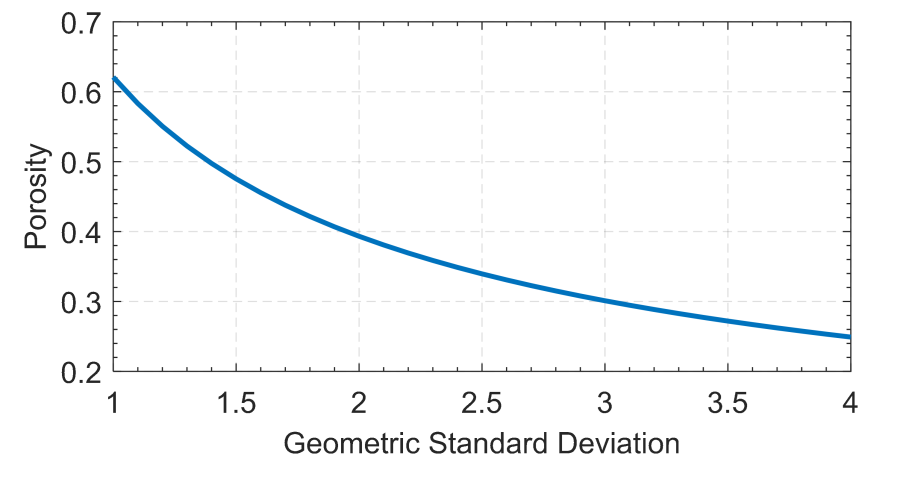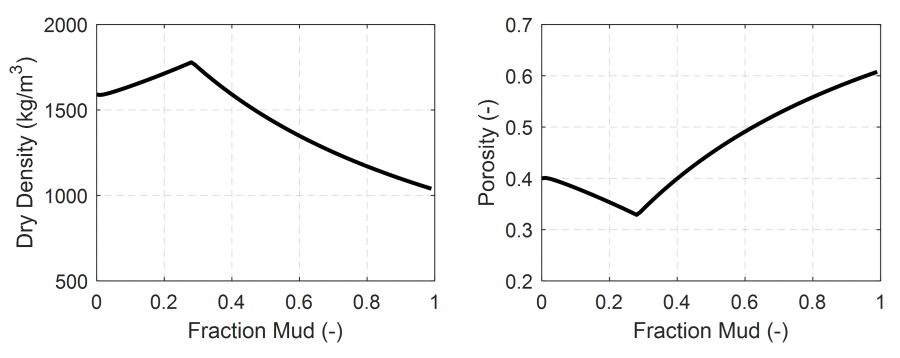Download PDF
Download page Porosity.
Porosity
The treatment of the porosity in HEC-RAS 2D sediment is different from that of HEC-RAS 1D. The dry bulk density is treated whenever possible as bulk property of sediment mixtures. There is not a one-to-one relationship between grain fractions and porosity. The temporal variation of the bed density is computed by solving for the fractional mass concentrations in each bed layer (analogous to sediment concentrations in the water column). The dry bulk density is the sum of the fractional mass concentrations. During this computation it is necessary to calculate the porosity of newly deposited sediments. Newly deposited sediments are mixed in the active layer with existing sediments to calculate the evolution of the active layer dry bulk density. The dry bulk density calculation is different for cohesive, noncohesive, and mixed cohesive/noncohesive sediments as outlined in the sections below. In addition, if the dry bulk density of the initial bed is not specified the same methods are applied to compute the initial bed. Therefore, the methods described below apply to both the initial bed and freshly deposited sediments.
Noncohesive Sediments
There are two methods in for estimating the dry bulk density of graded noncohesive sediments (i.e. sands and larger):
- Colby: User-defined noncohesive grain-class dry densities and the Colby (1963) formula
- Wooster: User-defined particle density, the empirical porosity formula of Wooster et al. (2008) and the Colby (1963) formula
The Colby (1963) formula is utilized when the user-specifies grain-class porosities, dry bulk densities, or dry unit weights, while the Wooster et al. (2008) formula is applied when these are left empty.
Colby
The simplest option to compute the noncohesive porosity the Colby (1963) formula
| 1) | \frac{\hat{f}_{n}}{1-\phi _{n}}=\sum _{k}\frac{\hat{f}_{k}}{1-\phi _{k}}\,\,\,\,\mathrm{for}\,\,k\in \,\text{noncohesive} |
where
ϕ_n: porosity of noncohesive deposited sediments [-]
\hat{f}_n = \sum_{k}\hat{f}_k \text{ for} k \in noncohesive : noncohesive fraction by volume [-]
\hat{f}_k: grain class fraction (by volume) of deposited sediments [-]
ϕ_k: user-specified porosity of grain class k [-]
It is noted that the grain class fractions above are represent the fractions by volume. This is necessary for simulating sediments with variable grain densities.
Wooster
There several formulas in literature for estimating the bed porosity of natural sands and gravels (e.g. Carling and Reader 1982; Wu and Wang 2006; Wooster et al. 2008). Rogers and Head (1961) who found that the bed porosity is mainly controlled by the sediment sorting and particle shape and presented several graphical curves. Frings et al. (2011) compared several formulas from literature to fluvial sand-gravel deposits and found that the best predictors for the sediment porosity were those methods which utilized the information on the entire grain size distribution such as the Wooster et al. (2008) formula given by
| 2) | ϕ_n = 0.621{σ_{gn}}^{−0.659} |
where ϕn and σgn are the porosity and geometric standard deviation of the deposited material, respectively. Although Wooster et al. (2008) developed their formula based on 32 laboratory samples with unimodal sediments packed by hand, they recommend the applicability of the formula to naturally packed sediment deposits or deposits with bimodal distributions.

Figure 1. Porosity as a function of geometric standard deviation from Wooster et al. (2008).
The geometric standard deviation of the noncohesive transported material is
| 3) | \sigma _{gn}=\exp \sqrt{\frac{1}{f_{n}}\sum _{k}f_{k}(\ln d_{k}-\ln d_{gn})^{2}}\,\,\,\,\,\mathrm{for}\,\,k\in \,\text{noncohesive} |
where
f_k: grain class fractions by weight [-]
d_k: characteristic grain diameter for grain class k [L]
f_n = \sum_{k}\hat{f}_k \text{ for} k \in noncohesive
d_{gn}: geometric mean of the noncohesive material [L]
The geometric mean of the transported material is
| 4) | d_{gn}=\exp \left(\frac{1}{f_{n}}\sum _{k}f_{k}\ln d_{k}\right)\,\,\,\,\mathrm{for}\,\,k\in \,\text{noncohesive} |
Cohesive Sediments
For fine sediments, the filling may be assumed to be negligible and following formula is used by Colby (1963)
| 5) | \frac{\hat{f}_{c}}{1-\phi _{c}}=\sum _{k}\frac{\hat{f}_{k}}{1-\phi _{k}}\,\,\,\,\mathrm{for}\,\,k\in \,\text{cohesive} |
where
ϕ_c: porosity of cohesive sediments [-]
f_k: grain class fraction by volume [-]
ϕ_k: user-specified porosity corresponding to each grain class [-]
Mixed Cohesive and Noncohesive Sediments
For mixed cohesive and noncohesive sediments the porosity of deposited sediments may be calculated assuming a bimodal mixture consisting of a cohesive and non-cohesive sediments with fractions f̂c and f̂n respectively. By definition f̂n + f̂c = 1. The porosity for the deposited mixture is calculated as (Han et al. 1981; Wu and Li 2017)
| 6) | \frac{1}{1-\phi }=\frac{\hat{f}_{n}}{1-\phi _{n}}(1-B)+\hat{f}_{n}B+\frac{\hat{f}_{c}}{1-\phi _{c}} |
where
B : filling or packing parameter [-]
\hat{f}_n = \sum_{k}\hat{f}_k \text{ for} k \in noncohesive : fraction by volume of noncohesive sediments [-]
\hat{f}_c = \sum_{k}\hat{f}_k \text{ for} k \in cohesive : fraction by volume of cohesive sediments [-]
ϕ_n: porosity of non-cohesive sediments [M/L3]
ϕ_c: porosity of cohesive sediments [M/L3]
The packing parameter is calculated following Wu et al. (2017) as
| 7) | B=\min \left(\frac{PR_{N}}{nN_{c}},B_{\max }\right) |
where
P=\frac{\hat{f}_{c}/d_{c}}{\hat{f}_{n}/d_{n}+\hat{f}_{c}/d_{c}}: probability of a coarse sediment particle contacting a fine sediment particle [-]
R_{N}=\frac{\hat{f}_{c}d_{n}^{3}}{\hat{f}_{n}d_{c}^{3}}: ratio of numbers of fine and coarse particles in the sediment mixture [-]
n=0.1124\frac{d_{n}}{d_{c}}: number of layers of fine particles to fill the void corresponding to each coarse particle [-]
N_{c}=\frac{4\pi }{\beta ^{2}cos30} : number of fine particles needed to cover the surface of a coarse particle [-]
\beta =2\sin ^{-1}\left(\frac{d_{n}}{d_{n}+d_{c}}\right)
d_c = {\hat{f}_c}^{-1} \sum_{k}\hat{f}_k \text{ for} k \in cohesive:= characteristic grain size for cohesive transported sediments [L]
d_n = {\hat{f}_n}^{-1}\sum_{k}\hat{f}_k \text{ for} k \in noncohesive : characteristic grain size for noncohesive transported sediments [L]
\hat{f}_c : fraction by volume of cohesive sediments [-]
\hat{f}_n : fraction by volume of noncohesive sediments [-]
B_{max} : maximum filling parameter (approximately 0.9) [-]
As an example of the Wu and Li (2017) method, the figure below shows the dry bulk density and porosity of a bimodal sediment mixture. The porosity of fines and noncohesives are 0.61 and 0.4, respectively. The grain density is 2650 kg/m3. The plots show how the porosity first decreases as the fraction of fines increases to a minimum value at around 30% fines, and then increases afterwards.

Figure 2. Example variation of dry bulk density (left) and porosity (right) for a bimodal sediment mixture of fines and sand.